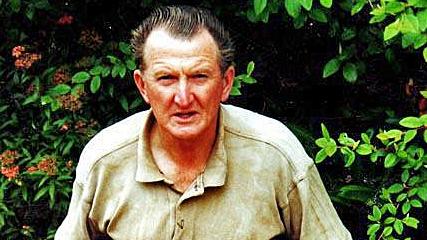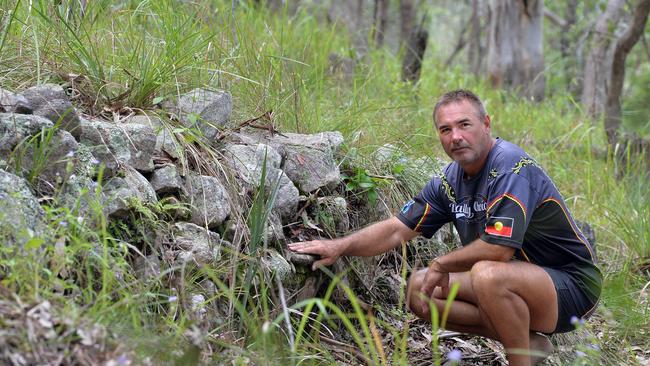Dr Elaine Brown debunks Gympie Pyramid extraterrestrial origin theories
A historian says she can separate fact from fiction with the Gympie Pyramid, which has been at the centre of claims tying it to the Egyptians, Incans and even extraterrestrials.

Gympie
Don't miss out on the headlines from Gympie. Followed categories will be added to My News.
The “Gympie Pyramid” became a global curiosity in 1975 when it was “discovered” by an avid investigator of unexplained phenomena and the paranormal.
Dr Rex Gilroy, whose career included hunts for the Yowie in the Blue Mountains, investigations into UFOs, and a stint as the director of the History museum at Mount Victoria, NSW, put the “pyramid” on the map when he travelled to Gympie to take a closer look at an uncovered “ape man” statue.
The “ape man” was a sandstone statue uncovered in 1966 on a rural property on Gympie Connection Rd, about two kilometres northeast of the city.
But it was the terraced structure on land directly opposite which caught the imagination.
Since its discovery explanations for the outcropping have included the weird, wonderful, and wacky.
Dr Gilroy posited that it was constructed by Egyptians who had been mining in the region.

Another theory, from amateur archaeologist Marilyn Pye, gave it an Inca origin while a third, by Gavin Menzies, claimed Chinese origins and that it was similar to observation platforms found during the Ming Dynasty which existed from 1368 to 1644.
Claims of alien origins for the structure have continued to hover on the outer fringes, and in some corners of social media.
A 2008 cultural heritage survey carried out on behalf of the state government’s Transport and Main Roads Department found “no evidence” of any connection to “Egyptian, Phoenician, Extra-terrestrial, Mayan or Chinese” visitors.
Local historian Dr Elaine Brown, who has researched the structure since its “discovery”, had a clearer description for these theories.
“It’s a hoax,” she said.
Dr Brown said its “discoverer” was “a fantasist” who “decided he had discovered a pyramid”.
She said the outcropping located at Rocky Ridge was exactly that: A rocky ridge of sandstone, similar to many other outcroppings across the region.
There was “no denying” the evidence which existed regarding the origins of the terraced structure.

Records showed John William Cauper owned the land from 1875 to 1890, and had cultivated it to grow fruit.
This included terracing the 16ha property, and exhibited in his letters at the time a practical knowledge of viticulture (the culture and harvesting of grapes, in which terraces can be used).
Mr Cauper’s land was divided up when he left the region, and media coverage across the years referred to it as an “old vineyard”.
Adding to the complexity was the land the “pyramid” stands on has been at the centre of ongoing fights and protests over claims of Indigenous heritage.
One group fighting to keep the land from being demolished as part of work on the $1bn Gympie Bypass, staunchly claims the Rocky Ridge was “Djaki Kundu” and had been used for gatherings and was of significant cultural heritage.
While the battle is ongoing, in 2021 occupation representative Wit-Boooka told media the debate over the “pyramid”, while often used interchangeably with their fight, was a different matter.
Wit-Boooka said the land had been owned by Mr Cauper and was “on the other side of the railway line”.
The wider claims of cultural significance at the area have been disputed over the years, including by those recognised as verified traditional owners of the land.
Multiple investigations have so far concluded the same.

In January 2021 protection applications made to the federal government under sections 9 and 10 of the Aboriginal and Torres Strait Islander Heritage Protection Act were rejected by the Department of Water, Agriculture and Environment.
The section 9 application was refused in May 2021 by former Environment Minister Sussan Ley as she was not satisfied it was a “significant Aboriginal area” as provided for under the Act.
The section 10 application was rejected in October 2021 following an independent assessment which returned a similar finding, at which point the Queensland transport department evicted protesters from the site.
Trespassing charges were laid against several protesters during the ensuing clashes, but were all eventually dropped.

Immediately after their eviction new section 9 and 10 protection applications were lodged over the area.
These included a new area along with the locations already rejected.
In October 2022 Environment Minister Tanya Plibersek made a “no declaration” order on the section 9 application.
A department spokeswoman said Ms Plibersek was not satisfied it was a significant Aboriginal area “on the evidence before her”.
The section 10 application is still under consideration. There is no time frame for it to be resolved.

That specific area of land containing the “pyramid” has since been protected from destruction by the state government, which cordoned off the outcropping from the path of the bypass.
Dr Brown said the “pyramid” did not become widely known until 1975 when it was “discovered” by Mr Gilroy.
She said no evidence has ever connected the sandstone “ape man” statue, discovered in 1966, tto the “pyramid”.
Claims across the years that stones from the “pyramid” had been stripped from the land and used in the wall of the city’s Uniting Church at Channon St had been debunked by Dr Brown too.
When it came to discussion of the ridge, and its origins, she came back to a single point.
“People need to look at the evidence,” Dr Brown said.
As to why the extraordinary and sometimes wacky claims about the “pyramid” persisted to this day?
“Some people like to live in a fantasy world,” Dr Brown said.
“People enjoy doing that.”





